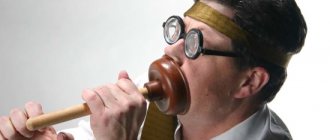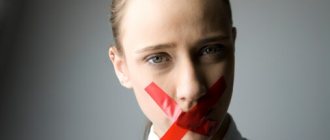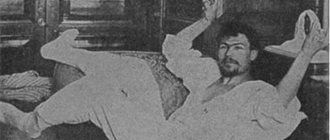Dyslalia is a defect in the pronunciation of sounds in children who do not have problems with hearing and normal innervation of articulation. Dyslalia in children manifests itself in the form of absence, replacement, or distortion of sounds. The word dyslalia comes from the Greek language, dys - disorder, lalia - speech. For this disease, a speech therapy study is carried out, during which mobility, the structure of the speech apparatus, and phonetic hearing are examined. Consultation with a neurologist, dentist, or otolaryngologist may be required.
General information about dyslalia
This speech disorder is not associated with damage and defects of the central nervous system and hearing. Dyslalia is the most common speech problem in children. It occurs in 25%-30%, and according to some data, in more than 50% of preschool children under the age of 7 years. 17-20% of junior schoolchildren and 1% of older students have various forms. In the structure of this disorder, polymorphic disorders in pronunciation stand out most of all.
They interfere with speech acquisition and are the causes of dysgraphia and dyslexia. This speech disorder is selective, meaning a child can pronounce up to 90% of words and sounds well, but have problems with the remaining 10%. Timely correction can completely rid a child of pronunciation problems.
What is dyslalia in children
Dyslalia is the incorrect use of sounds and a violation of their pronunciation. The disease is not associated with dysfunctions of the nervous system, speech apparatus, hearing or vision. The pathology is common among children of early school and preschool age.
According to statistics, modern children often suffer from polymorphic speech pronunciation disorders. Subsequently, this can lead to problems with written speech.
A feature of dyslalia is the absence of defects in the speech and hearing apparatus. The child speaks well, there is no diagnosis of delayed speech development.
Symptoms of dyslalia
It is not difficult to see and recognize the symptoms of dyslalia; this can be done by paying attention to your child’s speech. Characteristic symptoms are distortions, replacement of sounds or letters with others. The baby may completely skip some letters in his speech. If substitution occurs, the symptom is a change in the audible sound to another, which is pronounced by the child. For example, a child hears the word “cat”, but pronounces “goshka”. This phenomenon occurs due to the fact that he cannot differentiate sound by articulation and acoustics.
The patient can replace phonemes with arbitrary ones, in a chaotic order, regardless of the structure of the word. There is no division into sizzling, hard, soft and other types. Sometimes a child can pronounce the same word in different ways, including correctly. This indicates incomplete acquisition of phonemes. A child suffering from this disorder can be identified by his speech and pronunciation. They use sounds and letters that are not in the word. This is usually typical for the mechanical type.
If a child has functional dyslalia, one or more sounds in his speech are replaced. Mechanical dyslalia is characterized by problems with the pronunciation of similar phonemes. If there are pathologies in the development of the lower jaw, they will be pronounced by anterior lingual articulation. This occurs due to the inability to hold the tongue on the front teeth. This speech disorder may improve as people get older.
If parents notice such a disorder and seek help from speech therapists, there is a high chance of completely getting rid of this disorder. If he does not receive proper correction, he is also likely to get rid of dyslalia with age. Such children have a rich vocabulary, can break words into syllables, and over time they will develop correct speech. Speech therapists identify physiological dyslalia, which goes away by the age of five.
Reasons for appearance
After we have examined the definition of dyslalia and its varieties, let’s move on to the factors influencing its occurrence. According to its form, the causes of dyslalia are divided into organic (mechanical, anatomical) and functional.
In the first case, pronunciation defects appear due to the anatomically incorrect structure of the speech apparatus. As a rule, such deviations are inherited (the structure of the speech apparatus and its organs). With functional dyslalia, a person experiences disturbances in the functioning of the brain.
In most cases, speech problems arise due to anatomical changes in the lips and tongue.
If a person has bone abnormalities (bad bite, high palate, small teeth, etc.), then he has physiological dyslalia. It is a genetic disorder and is passed from parents to children. In some cases, it occurs after serious jaw injuries.
Sensory and motor functional dyslalia occurs only due to social and biological reasons.
Social reasons include:
- surrounding society with incorrect speech;
- “lisping” with a child (deliberately mispronouncing letters when speaking);
- simultaneous use of two languages in one environment (bulingualism);
- neglect of the child in upbringing.
Among the biological factors noted:
- delayed speech development;
- incorrect formation of phonemic hearing;
- high pain in the child.
The main forms of dyslalia appear precisely because of these reasons. Children under the age of 6 are most susceptible, since they are still learning and all actions are repeated after adults. Because of this, it is so important that the baby is surrounded by people with good speech and correct diction.
Impaired sound perception
Fluent speech is essential for success in school. It is for this reason that speech needs to be given special attention. The process of formation of the speech apparatus is influenced by several factors, including hearing. Any auditory pathology negatively affects pronunciation. The child hears a word, sound, or letter incorrectly, and accordingly pronounces it incorrectly. Phonetic or sound perception is the ability to correctly hear and distinguish the sounds “P-B”, “S-Sh”, “L-R”.
Often, children with impaired sound perception distort even phonemes that individually they can pronounce correctly. They are unable to analyze their speech well, may make mistakes when writing, and have difficulty reading aloud. Such violations require work and correction by speech therapists and teachers. Many of these disorders can be eliminated in preschool age, preventing them from developing into a persistent form, which will be difficult to correct.
It is important to know that at school age speech develops very intensively, it is flexible and pliable. A child with impaired hearing may not perceive close and similar sounds. There are no words in his vocabulary that contain combinations of letters that are difficult for him to distinguish. This ultimately leads to the fact that he begins to lag behind his peers.
Diagnostics
Establishing the correct diagnosis begins with general activities, which involve the clinician working with the patient’s parents and include:
- collecting a life history of a small patient, as well as studying data regarding the course of pregnancy and labor. In addition, it is very important for the doctor to find out what diseases the child has suffered. This often makes it possible to determine the causes and type of the disease;
- visual inspection - necessary to study the structure and mobility of the organs that make up the articulatory apparatus;
- a detailed survey of the patient’s parents regarding the first time of occurrence and severity of the characteristic symptoms of dyslalia in children.
Speech therapy examination is aimed at:
- assessment of the performance of some imitation exercises;
- studying the state of sound pronunciation - this will identify defectively pronounced sounds. In order to obtain relevant information, the doctor uses specific tests and asks you to repeat and draw what you heard. This is what will allow us to identify the nature of the violation, in particular the absence, replacement, confusion or distortion of sounds.
In addition, additional consultations with specialists from the following areas of medicine may be necessary:
- dentistry;
- child neurology;
- otolaryngology.
Some forms of dyslalia, in their clinical picture, may resemble other pathologies. It is for this reason that such a disease is, first of all, differentiated from an erased form of dysarthria.
Classification
There are different types of dyslalia, which are classified according to the causes of occurrence, severity, and types of sounds with which the child has difficulty. Considering the causes of pronunciation disorders, mechanical or organic, functional varieties are distinguished. Speech therapists have developed the following classification of dyslalia.
Mechanical
Mechanical dyslalia is caused by the anatomical structure of the articulatory apparatus. The reasons are:
- Disturbed dental system. Prognathia may be observed - protrusion of the upper jaw, which appears due to its too active growth compared to the lower one. The bite of the teeth may be disturbed, the presence of a large gap when closing the jaws or a violation of the structure of the teeth. These deficiencies are corrected by dentists.
- Irregularly formed palate. It can be narrow, high, flat, which creates difficulties with the articulation of many sounds.
- Irregularly shaped lips. Insufficient lip mobility and sagging affect correct pronunciation.
- Short frenulum of the tongue (hyoid ligament);
- Anatomical feature of the structure of the tongue. It can be big, short, small.
Material for the topic Causes of dysgraphia and methods of correction
Some of these reasons are easily remediable. This type does not affect the correct spelling or vocabulary.
Functional
Functional dyslalia is caused by social factors or correctable neurodynamic pathologies in the brain (brain cortex). There are several varieties - motor and sensory.
Motor type
Dictated by neurodynamic changes in the parts of the brain responsible for speech analyzers. Motor dyslalia is characterized by impaired movements of the tongue and lips, resulting in incorrect pronunciation. This phenomenon is called a phonetic defect.
Touch type
It is formed due to changes in the speech-auditory departments and affects hearing. The patient cannot differentiate sounds that have similar phonemes (hard-soft, voiced-voiceless, hissing-whistling). In speech, this leads to mixing, replacing, and omitting such letters, and in the future these letters can be omitted when writing.
The simultaneous presence of both types is called the sensorimotor type. Due to the unformation of certain sounds, three types of dyslalia can be distinguished:
- acoustic-phonemic,
- articulatory-phonemic;
- articulatory-phonetic.
Acoustic-phonemic
This group includes speech disorders due to the selective immaturity of the analysis of phonemes according to their acoustic parameters. The main violation in this case is insufficient sound perception, which is intended for recognition and differentiation by species. The sound that the child hears is recognized incorrectly by him, and therefore, he also pronounces it incorrectly.
It is important to know that with this type there are no hearing problems. The defect is selective for certain phonemes. Acoustic-phonemic dyslalia should not be confused with severe speech disorders.
Articulatory-phonemic
This group includes defects associated with the immaturity of operations for selecting phonemes according to their articulatory characteristics. There are two types of violations. In the first case, the articulatory base is not fully formed. Instead of the sound needed in this case, the child chooses a sound close to it in its articulatory characteristics.
The second option is characterized by the complete formation of the articulatory base. The child knows all the phonemes that are required for correct pronunciation, but when pronouncing words, some letters are replaced by others according to the principle of substitution. These substitutions occur according to the principle of articulatory proximity of phonemes - “rat” - “roof”.
Articulatory-phonemic
Characterized by defects in the sound design of speech due to improperly formed articulatory positions. Sounds can be pronounced in a distorted form, but this happens in unusual ways. This kind of speech is easy to understand.
Heaviness
Depending on the number of sounds that are pronounced incorrectly, dyslalia can be simple or complex. With a simple type, 1-4 sounds are impaired, with a complex type, more than four sounds are impaired.
Monomorphic type
It is difficult to pronounce one of the groups, for example, only voiced or only hissing.
Polymorphic
Sounds with which there are difficulties belong to different groups. Phonetic defects are designated by terms that are derived from the Greek alphabet:
- rhotacism – problems with the letter “P” and P is soft;
- lambdacism - “L” and “L soft”;
- sigmatism – the pronunciation of hissing sounds (zh, sh, shch, h) and whistling sounds (s, z) is impaired;
- iotacism – difficulties with “Y”;
- gammacism - “G” and “G soft”;
- kappacism - “K”, “K soft”;
- hittism – “X”;
- difficulties with voicing and deafening - replacing voiced consonants with voiceless ones and vice versa;
- softening and hardness defects - replacement of soft with hard ones or vice versa.
There may be complex forms that are combined in nature - the addition of several defects to each other. If there is a phonemic defect, that is, a sound replacement, the prefix “pair” is added to the name of the defect. This is how paralambdacism, parasigmatism and others are formed.
Causes of mechanical dyslalia
The main reason for the development of this type of dyslalia is an organic defect. That is, the child or adult had an incorrectly developed articulatory apparatus (lips, tongue or jaw).
Among the most common anomalies that provoke such speech problems are:
- Short frenulum of the tongue. If the hyoid ligament is shortened, then in this case problems arise with the upper lingual sounds.
- Macroglossia and microglossia. These are disorders in which the tongue may be too massive or, conversely, small. As a rule, children with physical or mental retardation suffer from such problems.
- Too thick or inactive lips. In this case, the person cannot pronounce labial or labiodental sounds correctly.
Problems can also arise due to an incorrect bite or improper structure and growth of teeth.
Forms of dyslalia
There are two forms of dyslalia - functional and organic or mechanical. If the child does not have organic disorders caused by the peripheral or central nervous system, we can talk about functional dyslalia.
This type appears in childhood, when the correct pronunciation of sounds is learned. Mechanical speech can appear at any age due to disturbances in the peripheral speech apparatus.
Functional dyslalia includes defects in the pronunciation of sounds - phonemes, without mechanical articulation disorders. Its causes are: physical weakness due to somatic diseases;
- delayed psychological development (minor disturbances in brain activity);
- delays in speech development;
- disorders associated with phonetic perception;
- social environment (incorrect speech of adults, insufficient communication with other children and adults, insufficient attention to raising the child).
All these reasons are not critical and can be eliminated by the work of qualified psychologists, speech therapists and other child development specialists.
Correction of various forms of speech disorders
If there is an incorrect pronunciation of sounds belonging to one group, for example, whistling, we are talking about simple violations. To correct them, 2-3 months of cooperation with a speech therapist is enough, sometimes correction can last six months. But complex dyslalia in children, which is characterized by impaired pronunciation of 5 or more groups of sounds, requires longer and more painstaking work.
In most cases, with complex forms, children have impaired phonemic hearing. In the process of correction, difficulties arise not with the fact that it is necessary to “set” a large number of sounds, but with the fact that the child begins to hear them correctly. This takes a lot of time. It is important that the child completes tasks not only with a speech therapist, but also with his parents at home. Only with regular and systematic exercise can speech be restored in a short time.
Pathogenesis of dyslalia
The reasons vary for different types. Accordingly, the correction required is different.
Physiological prerequisites for mechanical dyslalia
The mechanical type is caused by physiological and anatomical defects. They do not make it possible to pronounce sounds correctly, the sound that they heard. This usually occurs due to dental defects - bite, incorrect shape and location of incisors, underdeveloped jaws. Doctors consider the main reasons:
Choose a feedback specialist, study individually or in a group.
Speech therapist help online
Speech therapists, speech pathologists, preparation for school. Distance learning online.
Speech therapist via Skype
Specialized education to help children and adults with speech disorders.
Retraining to become a speech therapist
- the frenulum of the tongue is too short;
- structural features of the bones of the jaw and face;
- palate defects;
- pathology of the upper lip;
To get rid of mechanical dyslalia, a dentist and an orthodontist are needed. The child must undergo a special correction course. The best results are achieved at the age of 5-6 years.
Complex dyslalia
Dyslalia in speech therapy can also manifest itself in more complex forms. These are situations where several defects are combined at once. The most common are rhotacism and lambdacism and rhotacism and sigmatism.
If a person has a too short hyoid frenulum, then in this case he pronounces the sound [r] very muffled or replaces it with other phonemes that belong to the category of lower softening sibilants.
The patient may also suffer from a defect in contrasting sounds according to their parameters of hardness and softness or voicedness and deafness. The most complex type of deviation is total dyslalia. In this case, the child pronounces almost all consonant sounds incorrectly. However, most often no problems are observed with vowel sounds.
There is also such a thing as Hottentatism. In this case, of all the consonants, the child pronounces only [t].
Prerequisites for functional dyslalia
This type develops due to the abnormal mental or physical state of the child. Often this diagnosis is made to children experiencing problems with mental development. In this case, the structure of the speech apparatus does not suffer, hearing is normal, and the innervation of the muscles responsible for articulation is not impaired. In children with the speech problem under consideration, the structure of the peripheral speech apparatus is normal, the innervation of the articulatory muscles is not impaired. There are two types of factors that cause this type of dyslalia.
Material on the topic How to get rid of a lisp at any age
Biological background
This group of factors includes:
- delayed psycho-speech development;
- somatic diseases;
- infectious diseases suffered during the period of active speech development;
- chronic diseases;
- hypovitaminosis;
- nutritional disorders (dystrophy).
These disorders affect neurodynamics, which is responsible for the differentiation of the speech-hearing apparatus and the speech-motor analyzer. With this manifestation, articulatory movements are not accurate enough, and speech kinesthesia may be observed.
Social preconditions
This group of factors includes:
- improper speech education;
- parents copying babbling words;
- consolidation in speech of incorrect sound pronunciation on the part of adults (burr, lisp, dialect).
During the period of speech development, a child may find himself in a bilingual environment, which can also lead to the development of dyslalia. In this case, the pronunciation rules of one language apply to the other.
Pathogenesis
Functional dyslalia is associated with an imbalance and weak dynamics of the nervous processes occurring in the child’s brain. The cortical areas do not have pronounced pathologies, but there is insufficient coordination between speech excitation and inhibition. The nature of the speech disorder is determined by the localization of the neurodynamic disorder in the subcortical region of the brain. If the entire speech department is affected, motor failure occurs, the pronunciation of individual phonemes suffers, and, secondarily, speech hearing.
If the localization is in the sensory zone (Wernicke's center), defects in sound perception primarily appear, which leads to expressive speech. This is how phonemes are mixed and replaced.
Social prerequisites for functional dyslalia
Social preconditions are those associated with adults. These include:
- parents may lisp;
- parents often make mistakes in their speech;
- being in a bilingual environment;
- they do not study enough and pay little attention to it (pedagogical neglect);
- reduced differentiation of hissing and whistling sounds;
- delays in mental development.
All these reasons can be eliminated if appropriate correctional work is carried out by speech therapists, psychologists, and parents.
Simple dyslalia
Dyslalia in speech therapy is a defect that can be simpler when only one group of phonemes changes. Such situations occur quite often in medical practice.
Sigmatism
In this case, a person cannot correctly pronounce hissing [zh], [sh], [sch], [h] and whistling phonemes [s], [s'], [z], [z'].
Rotacism
This deviation affects only the sounds [p] and [p']. This is a very common type of dyslalia. Children can pronounce these phonemes correctly only after 2 years. In most cases, it's all about articulatory preparation. The child does not immediately understand how to place his tongue correctly to pronounce these sounds.
There are several types of rotacism:
| Type of rhotacism | Peculiarities |
| Side | When pronouncing sounds, the lateral edges of the tongue do not come into contact with the upper outer teeth. |
| Gorlova | The root of the tongue is weak. |
| Velar | As soon as the tongue approaches the hard and soft palate, vibration begins. |
| Uvular | The small tongue vibrates. |
| Rolling | The tongue moves too intensely. |
| Freaky | The sound [r] is pronounced in English moner. |
Pararotacism
In this case, instead of [r], the person pronounces [l]. A slightly less common replacement is [d] or [g]. There are about 30 subtypes of this type of deviation.
Lambdacism
Most often, there is a slight replacement of the sound [l] with [l'].
In more rare cases, a person pronounces [th] instead of this phoneme.
Parasigmatism
It can be interdental, lateral, and slightly less frequently interdental. A person changes [f] to [w], [sh] to [s]. There are other variations. This defect is symmetrical. This means that if there is a problem with soft sounds, the person will also distort the soft ones.
Yotacism
With such a deviation, the patient cannot pronounce [th] correctly. It replaces this sound or simply “swallows” it.
Gamacism
Characterized by a lack of pronunciation of the phonemes [g] and [g']. The patient can also replace them with similar ones when the tongue is in the closest position to the correct position.
Kappacism
The patient cannot pronounce [k] and [k'] correctly.
Hitism
Problems arise with the phonemes [x] and [x']. During pronunciation, the tongue may vibrate too much.
Features of the course of complex dyslalia
The more complex the combination of disorders, the more difficult it is to cope with it. Accordingly, this affects the general background of the disease. In complex forms, mental and general developmental delays may be observed. It is necessary to engage in in-depth research of the child in the aspect of his psyche, intellectual development, hearing, and vision. Complex dyslalia may be a signal that there are problems with them. People who are hard of hearing often distort or change the “T” sound.
A child with second or third degree hearing loss does not have a metallic tone in his voice. The voice has softness or, in other words, viscosity. Children with vision problems may have dyslalia defects corresponding to its complex types. This is caused by poor visual control. In such patients, sigmatism is observed 4 times more often than in healthy children.
Defects in contrasting consonants in deafness and voicedness
Dyslalia in speech therapy is a very broad topic that includes problems with the pronunciation of consonants with incorrect voicing and deafness. According to the ontogenesis of speech, the child begins to distinguish such phonemes quite late due to their acoustic proximity. But later this feature of the Russian language should be quite easy to learn.
However, defects of this type occur in 4% of cases in children diagnosed with sound pronunciation disorders. The cause of this deviation is most often improperly developed phonemic perception or problems with coordination of the vocal or articulatory apparatus. Often the defect appears simultaneously with the development of hearing loss or problems with the vocal cords.
This type of deviation is quite easy to identify:
- a person begins to deafen voiced phonemes;
- the patient, on the contrary, pronounces voiceless consonants too loudly;
- voiced and unvoiced sounds are mixed.
Diagnosis of dyslalia by the nature of speech impairment
Diagnosis of dyslalia begins with finding out all the features of the course of pregnancy, childbirth, and illnesses the mother suffered during this period. What matters are the child’s illnesses that he suffered at an early age and his psychomotor development. Other factors also influence the diagnosis:
- features of speech development at an early age;
- hearing;
- vision;
- condition of the musculoskeletal system.
In order for the specialist to have a complete understanding of this, it is recommended to show all available medical documentation. After identifying these factors, the speech therapist proceeds to examine his patient. He examines the articulatory apparatus and determines their mobility. This happens through special exercises and tasks that the child must complete.
The diagnosis of dyslalia includes analysis of sound pronunciation, determination of speech defects, their nature, depth, and degree of complexity. Particular attention is paid to phonetic hearing - the ability to differentiate sounds into groups. The speech therapist’s conclusion indicates the form of dyslalia, the type (articulatory-phonemic, acoustic-phonemic, articulatory-phonetic), and the type of sound pronunciation (rhotacism, sigmatism, etc.).
If you have mechanical dyslalia, consultation with a dentist and orthodontist is required. For functional – a neurologist and analysis on his part. Diagnostics by an otolaryngologist will also be required to examine the hearing aid. The main goal is to accurately determine the child’s condition and the level of development of his speech apparatus. Correct diagnosis is necessary for accurate and correctly selected correction.
Differential diagnosis of erased dysarthria and dyslalia
There are common symptoms of two speech disorders, which can mislead a specialist when making a diagnosis. The table below presents the main characteristic features that will help differentiate erased dysarthria and dyslalia.
Table for differentiated diagnosis of erased dysarthria and dyslalia.
Prevalence of the problem
Dyslalia is a common problem. There are different estimates on this matter, on average, the number of children suffering from this speech disorder is about 25-30% in preschool age. As you get older, this number decreases. At primary school age this percentage drops to 17-20%. At older ages there are only 1-2% of such children.
The disease is a common occurrence, most common in the practice of speech therapists. According to various estimates, the average number of children with such problems in preschool age is 25-30%, in elementary grades – 17-20%, and in older age – 1%.
More often in the practice of speech therapists there are combined articulation disorders that create a barrier to the development of writing. Children, at the same time, have an extensive vocabulary, the structure of speech is not disturbed. All grammatical laws are observed - cases, declensions, endings.
Material on the topic Aphasia: causes and symptoms of speech disorder, methods of diagnosis and correction
Symptoms of the disorder
An adult can easily notice deviations from the norm in the perception and reproduction of sounds by children, although in the practice of a speech therapist there are more often cases when parents do not notice all the deviations in their child’s pronunciation.
When replacing sounds, children do not distinguish similar phonemes by sound and replace one sound with another. Most often, symptoms manifest as tongue-tiedness. For example, a child confuses deaf and voiced consonants, soft and hard (tree - tree, paw - blooper). If the difference in articulation is insignificant, and the sounds are formed in the same place, for example: instead of [P], [L] or [D] may sound (fish - lyba), instead of C - CH (chicken - chipling), etc. .
Sometimes a child has difficulty choosing a sound, although he can pronounce it correctly in individual words (Shapka speaks, but makes mistakes kaSya in the word porridge), that is, the same sound is pronounced differently depending on the situation. In some cases, children pronounce the sounds of the Russian language in a way atypical for the language system - throat (French) [P], specific [Z], similar to the English the.
Substitutions and confusion of phonemes refer to phonemic defects, distortion of sounds - to phonetic types of pathology.
The connection between dyslalia and dyslexia and dysgraphia
Dysgraphia and dyslexia are the inability of a child to master reading and writing skills while maintaining their intellectual capabilities. Often these diagnoses can be observed simultaneously. There is alexia - a complete inability to read, agraphia - writing. In practice, children suffering from dyslalia are more likely to have these disorders. Elimination and corrective work with dyslalia leads to improvement in dysgraphia and dyslexia.
Sound production stage.
The goal of this stage is to develop the initial skills of correctly pronouncing a sound and is achieved in two ways:
- By imitation;
- With mechanical assistance.
The production of sound with mechanical assistance depends on the characteristics of its articulation. Probes, spatulas, and probe substitutes can be used as mechanical assistance.
Video: setting the sound p
Important to remember! The production of sounds should be carried out by a speech therapist exclusively in the conditions of individual work with the child.
Methods for correcting dyslalia
Speech therapy correction, depending on the severity of dyslalia, consists of several stages. The duration can take one to six months. Correction stages:
- Preparatory work with the reproduction of phonemes. Here they practice various breathing techniques, phonetic hearing, and work with reference sounds.
- Staging impaired sounds, forming correct articulation. Special tools can be used for this. The result of the work is the pronunciation of sounds without the help of adults.
- Consolidation of the obtained results. First, in individual syllables, and then in words and sentences.
- Differentiation. The patient learns to distinguish and correctly speak the sounds that he himself pronounces.
All methods are aimed at identifying sounds, the ability to distinguish them, improve memory, and develop communication skills.
Preparatory stage
The child must be involved in the speech therapy process. The speech therapist establishes contact and trusting relationships with the child, giving the child time to adapt to new conditions. Also at this stage are:
- development of attention;
- memory;
- thought process;
Staging
The correct sounds are set and the child’s articulation is formed using special materials and exercises. At this stage, sounds differentiation skills are developed. There are three ways to do this:
- First way. The child himself makes conscious attempts to establish correct articulation. An adult should simply help him with this. Tactile, visual, and acoustic exercises can be used.
- Second way. External mechanical influence on the child and his articulatory apparatus. The speech therapist should ask you to repeat the sound several times, and then use probes to place this sound correctly. In the future, improve pronunciation without using a tool.
- The third method is a combination of the first two.
Each of these stages has a varying degree of difficulty and is selected by a speech therapist.
Exercises to eliminate mechanical dyslalia
With this type of dyslalia, the child's speech passes through the teeth. He cannot move his lower jaw, in particular, open his mouth wide. The problem lies in the incorrect forcing of the articulatory apparatus - facial muscles, bite and others. They can be developed with special exercises. They need to be done together with adults, sitting in front of the mirror and observing his (the child’s) actions, controlling and correcting him.
You should start by opening and closing your mouth, gradually increasing the gap between the jaws. A set of exercises is selected directly by the speech therapist for a specific case. There are basic exercises that are used in most cases:
- Smile. The lips should be in a smiling position. The front teeth should be visible and remain in this position for 10 seconds.
- Tube. The teeth are pressed tightly, the lips are pulled forward, taking the shape of a tube, also for 10 seconds.
- Alternate “smile” and “pipe” at least 10 times.
- Funnel. The teeth should be open, the lips should be pulled forward. On the count of “two,” they pull into their mouth, tucking themselves in behind their teeth. Repeat 10 times.
- Timpani. Lips go behind teeth. They need to clap, making the appropriate sound.
- Horse. You need to relax your lips and make movements with them that imitate the snorting of a horse.
- Bolt. Clenched teeth, lower lip should move left and right.
- Hide and seek. Hide your lower lip behind your upper teeth. Only the lip should be visible. Hold this position for 5 seconds. Do the same exercise with the lower lip and alternate them 10 times each.
Treatment
Stages of speech therapy for dyslalia
Correction of dyslalia is carried out using conservative methods and consists of several stages:
- preparatory;
- phases of formation of primary pronunciation skills;
- creation of communication abilities.
At the preparatory stage the following is carried out:
- elimination of anatomical disorders associated with the structure of the articulatory apparatus - this is indicated for organic dyslalia;
- articulatory gymnastics and speech therapy massage – when diagnosing the motor form of functional dyslalia;
- development of phonemic processes – in the presence of sensory functional speech impairment;
- improvement of fine motor skills;
- development of processing of sound pronunciation.
The phase of developing primary pronunciation skills is aimed at:
- production of a single sound;
- automation of sounds in a syllable, word, sentence and text;
- development of the ability to differentiate sounds.
At the last stage of treatment for dyslalia, the skills of error-free use of sounds are consolidated, regardless of the communication situation.
It is very important that classes with a speech therapist are held regularly, namely at least three times a week. Not least important is home therapy, aimed at completing tasks set by the clinician and performing articulatory gymnastics exercises. The duration of such treatment can vary from one month to six months, depending on the form and degree of neglect of the disease.
New technologies in the correction of dyslalia
The connection between speech therapy and orthodontology has been established for a long time, this is especially true for mechanical dyslalia. In this area, there are modern solutions to problems that lead to such speech disorders. Such an example is myofunctional containers, vestibular plates. Containers appeared not so long ago, and their effect on speech became known only recently - about four years ago. Mechanical dyslalia is caused by malocclusion and abnormalities in the dentofacial apparatus; a speech therapist cannot influence, much less eliminate, this problem.
In 2008, studies were conducted using myofunctional correction tools. These are trainers made of silicone. The results showed that 100% of children regained breathing through their nose, and 99% normalized their speech disorders. Based on this work, it was concluded that the preorthodontic trainer has proven its clinical effectiveness in practice and can be used to correct breathing and occlusion in a child.
Measures to prevent dyslalia
The main preventive measures are:
- For full speech development and the formation of the articulatory apparatus, the child must receive solid food.
- Speech disorders occur in children who receive only soft foods more often than in others.
- It is necessary to develop the child's fine motor skills.
- Identify existing speech disorders and begin to eliminate them.
Attention to the child’s speech problems and adequate correction will help avoid negative consequences and eliminate all problems in a timely manner.











